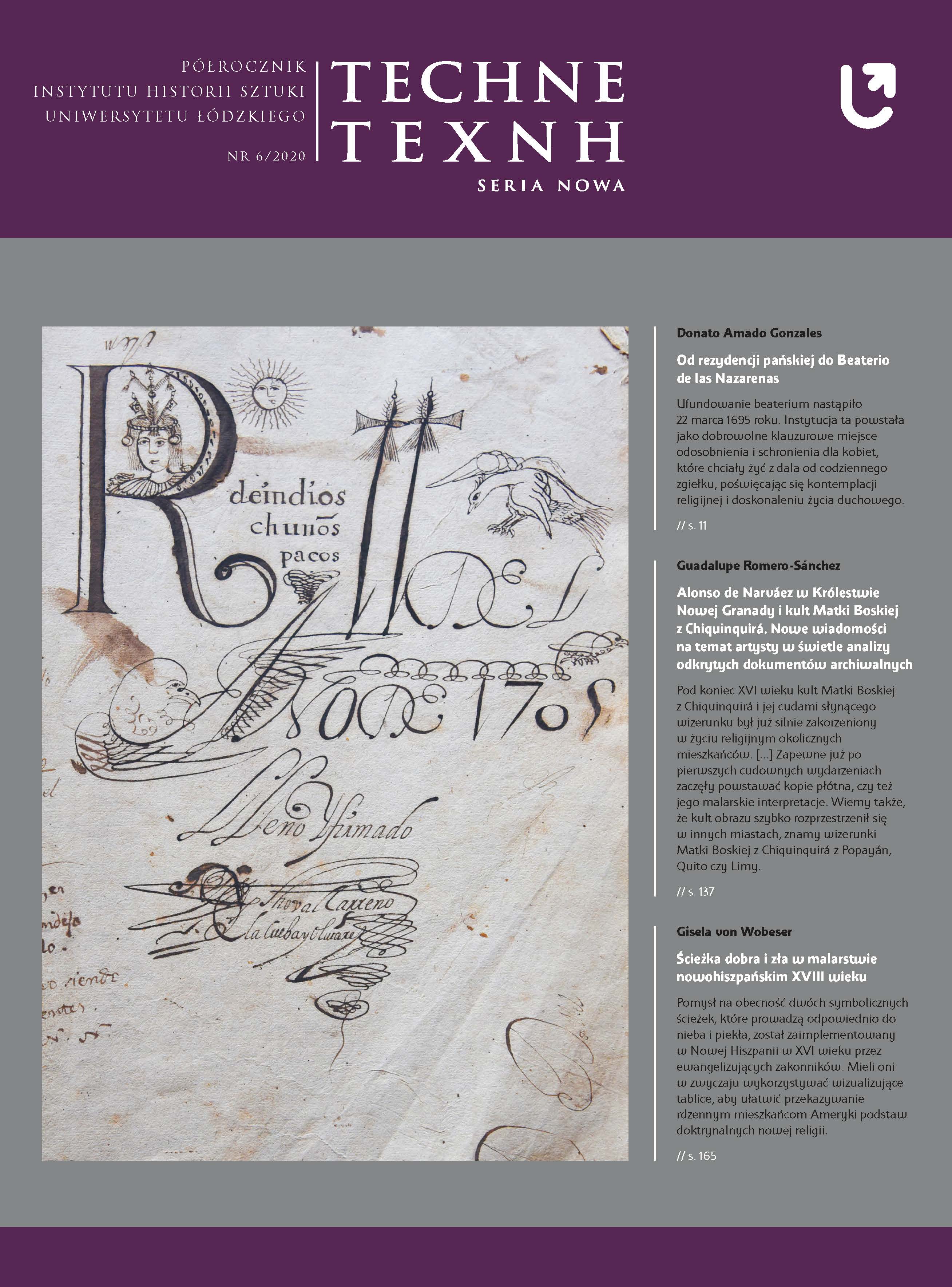Motif of Cavia Porcellus (Guinea Pigs) in Modern European Painting
DOI:
https://doi.org/10.18778/2084-851X.10.04Keywords:
Cavia Porcellus, guinea pig, European painting, modern iconographyAbstract
This paper presents European reception of a guinea-pig motif on the example of paintings from the 16th to 18th centuries. Interpretation of its significance in early Europe is interesting insofar as it concerns an animal with an already established cultural function. After all, the guinea pig’s homeland is South America, where it was bred for food, but also played an important social and religious role. When a domestic guinea pig was brought to Europe, it fundamentally changed its original role. As a new animal with exotic connotations, it gained the status of a valuable faunal specimen and soon became a breeding animal extremely fashionable among the upper class.
This evolution can be observed in the field of art. Cavia Porcellus starts to be depicted in representations of a zoological and scientific nature. Initially, the image of a guinea pig is placed in lexicons, and from there it makes its way into elaborate animalistic compositions that enable depiction of the widest possible spectrum of diverse fauna. A natural history perspective, which incorporated a guinea pig into the European bestiary, significantly influenced further development of, now independent, images of the animal. They became most widespread at the turn of the 17th and 18th centuries, especially among artists associated with court circles. Created for wealthy collectors, these depictions expressed a peculiar fashion for this particular animalistic theme, as evidenced by mutual borrowings among painters taking up the motif.
References
Acosta 2006 [1590] – José de Acosta, Historia natural y moral de las Indias. En que se tratan de las cosas notables del cielo / elementos / metales / plantas y animales dellas y los ritos / y ceremonias / leyes y gobierno de los indios, México 2006 [1590].
Google Scholar
DOI: https://doi.org/10.5962/bhl.title.137953
Arriaga 1621 – Pablo José de Arriaga, Extirpación de la idolatría del Peru. Dirigido al Rey N. S. en su Real Conseio de Indias. Por el padre Pablo Ioseph de Arriaga de la Compañia de Iesus, Lima 1621.
Google Scholar
Biblia Tysiąclecia 1971 – Pismo Święte Starego i Nowego Testamentu. Biblia Tysiąclecia, red. o. Augustyn Jankowski, w przekładzie z języków oryginalnych, oprac. zespół biblistów polskich z inicjatywy benedyktynów tynieckich, wyd. drugie poprawione, Warszawa 1971.
Google Scholar
Cobo 1964 [1653] – Bernabé Cobo, Historia del Nuevo Mundo, t. 1, Madrid 1964 [1653].
Google Scholar
DOI: https://doi.org/10.1136/bmj.1.5399.1653
Gesner 1620 [1551] – Conrad von Gesner, Historiae animalium. Liber primus. De Quadrupedibus viviparis, wyd. drugie, Francofurti 1620 [1551].
Google Scholar
Białostocki/Walicki 1955 – Jan Białostocki, Michał Walicki, Malarstwo europejskie w zbiorach polskich 1300–1800, Warszawa 1955.
Google Scholar
Chmielewski 2015 – Filip Chmielewski, O motywie świnki morskiej na obrazach trzech artystów: Giovanniego Agostina Cassany, Teodora Lubienieckiego i Franza Wernera von Tamma, „Barok” 2015, XXII/2 (44), s. 79–102.
Google Scholar
Chudzikowski 1967 – Andrzej Chudzikowski, Malarstwo europejskie. Katalog zbiorów, t. 1, Warszawa 1967.
Google Scholar
Cichocki et al. 2015 – Włodzimierz Cichocki et al., Polskie nazewnictwo ssaków świata, Warszawa 2015.
Google Scholar
Cooper/Eade 2013 – Tarnya Cooper, Jane Eade, Elizabeth & and Her People, London 2013.
Google Scholar
Dittrich/Dittrich 2004 – Sigrid Dittrich, Lothar Dittrich, Lexikon der Tiersymbole. Tiere als Sinnbilder in der Malerei des 14.–17. Jahrhunderts, Petersberg 2004.
Google Scholar
Dudek-Bujarek 2007 – Teresa Dudek-Bujarek, Stała ekspozycja sztuki od XIV wieku do dwudziestolecia międzywojennego XX wieku. Przewodnik, Bielsko-Biała 2007.
Google Scholar
Erlendsdóttir/Martinell/Söhrman 2017 – De América a Europa. Denominaciones de alimentos americanos en las lenguas europeas, red. Erla Erlendsdóttir, Emma Martinell, Ingmar Söhrman, Madrid–Frankfurt am Main 2017.
Google Scholar
DOI: https://doi.org/10.31819/9783954876778
Gawrycki 2014 – Marcin Florian Gawrycki, Chrystus jada cuy. Latynoamerykańska sztuka kulinarna nie od kuchni, Warszawa 2014.
Google Scholar
Genaille 2001 – Robert Genaille, Encyklopedia malarstwa flamandzkiego i holenderskiego, Warszawa 2001.
Google Scholar
Hyams 1974 – Edward Hyams, Zwierzęta w służbie człowieka, tłum. Joanna Gliwicz, Warszawa 1974.
Google Scholar
Katalog Galerii Malarstwa Obcego 1938 – Katalog Galerii Malarstwa Obcego. Muzeum Narodowe w Warszawie, oprac. Juliusz Starzyński, Michał Walicki, Warszawa 1938.
Google Scholar
Kobielus 2002 – Stanisław Kobielus, Bestiarium chrześcijańskie. Zwierzęta w symbolice i interpretacji. Starożytność i średniowiecze, Warszawa 2002.
Google Scholar
Kolb 2005 – Arianne Faber Kolb, Jan Brueghel the Elder. The entry of the animals into Noah’s Ark, Los Angeles 2005.
Google Scholar
Lasota-Moskalewska 2005 – Alicja Lasota-Moskalewska, Zwierzęta udomowione w dziejach ludzkości, Warszawa 2005.
Google Scholar
Lejman 2012 – Beata Lejman, Malarstwo Europy Środkowej XVI–XVIII w. Niemcy, Austria, Czechy, Węgry, Słowacja, Wrocław 2012.
Google Scholar
Porzio 1989 – Francesco Porzio, La natura morta in Italia, t. 1, Milano 1989.
Google Scholar
Purc-Stępniak 2007 – Beata Purc-Stępniak, Bogaty świat zwierząt, [w:] Malarstwo flamandzkie doby Rubensa, van Dycka i Jordaensa 1608–1678, red. Antoni Ziemba, Warszawa 2007, s. 211–233.
Google Scholar
Steinborn 2006 – Bożena Steinborn, Katalog zbiorów malarstwa niderlandzkiego, Wrocław 2006.
Google Scholar
Steinborn 2012 – Bożena Steinborn, Katalog zbiorów malarstwa krajów romańskich, Wrocław 2012.
Google Scholar
Tomkiewicz 1972 – Władysław Tomkiewicz, Lubieniecki Teodor, [w:] Polski słownik biograficzny, t. 17, Wrocław 1972, s. 607–608.
Google Scholar
Tongiorgi Tomasi/Nygren 1998 – Lucia Tongiorgi Tomasi, Christopher J. Nygren, Animal subjects, [w:] The Dictionary of Art, t. 1, London 1998, s. 102–108.
Google Scholar
Walicki 1949 – Michał Walicki, Z dziejów barokowego portretu polskiego, „Rozprawy Komisji Historii Kultury i Sztuki” 1949, t. 1, s. 196–230.
Google Scholar
Walicki 1961 – Michał Walicki, Lubienieccy, Warszawa 1961.
Google Scholar
Wołoszyn 2011 – Janusz Z. Wołoszyn, Kulinarna selekcja, czyli o tym, jak świnka morska nie trafiła do światowego menu, „Przegląd Historyczny” 2011, t. 102, s. 637–659.
Google Scholar
Zendt 2010 – Christina Zendt, Marcos Zapata’s Last Supper. A Feast of European Religion and Andean Culture, „Gastronomica” 2010, nr 4, s. 9–11.
Google Scholar
DOI: https://doi.org/10.1525/gfc.2010.10.4.9
Downloads
Published
How to Cite
Issue
Section
License

This work is licensed under a Creative Commons Attribution-NonCommercial-NoDerivatives 4.0 International License.








